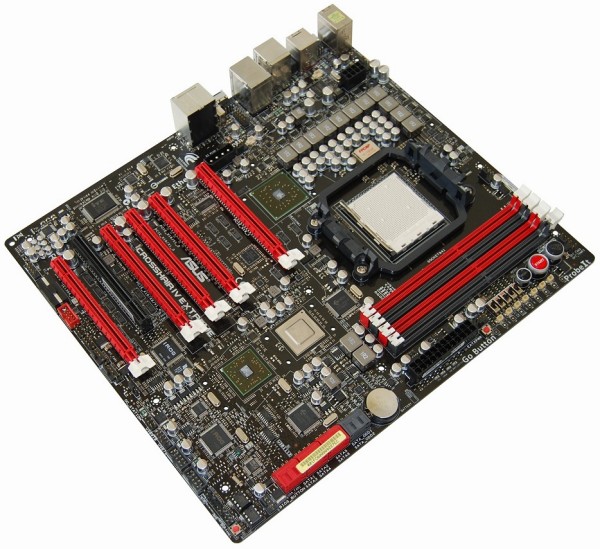Board Design & Layout
Upon first glance, the Asus Crosshair IV Extreme makes prominent use of an advanced cooling setup. Heatpipes connect the SB850 southbridge and Lucid HydraLogix engine to the massive heatsink covering the power phase circuitry and 890FX northbridge chip. The 890FX northbridge is one of the most power-hungry chips of the AMD 8-series, consuming 19.6 watts, so the larger heatsink is probably warranted.



We dislike the small blower fan embedded in the large primary heatsink as it emits a high pitch noise that can be heard over the other system fans. The current BIOS version doesn't provide control over this fan, so there's no way to slow it down. If you feel your CPU cooler directs enough air over the motherboard, you can always opt to unplug the built-in fan.

The Crosshair IV Extreme features the new Extreme Engine Digi+ (8+2 phase CPU power design with ML Cap) which is designed to combine high quality analog and digital design elements that provide optimum electrical, thermal and material performance for reduced switching delay times and improved signal accuracy.

Typical digital VRMs requires a high switching frequency of 800KHz or above to operate due to their logical limitation, but the ROG Extreme Engine Digi+ is capable of delivering the same level of power stability with a switching frequency as low as 250KHz. This allows for a lower operating temperature and greater efficiency.
Extreme overclockers will also appreciate the ROG Crosshair III Extreme's LN2 mode that solves cold-boot bugs which can crop up with liquid nitrogen cooling, while Q Reset offers a quick and easy way to clear the CMOS when frosting prevents a reset in standby mode.

As you would expect from a tier 1 board maker, the Crosshair IV Extreme's design is very neat and tidy. Often we find that when the DIMM slots are too close to the primary PCI Express slot, it becomes impossible to install memory modules without first removing the graphics card. This can be a hassle for those with a large graphics cards in small cases, as they can be quite awkward to remove.

Asus has excluded the DIMM slot clips from the bottom of the slots, keeping them only at the top where they are easily accessible. This means that users only have to use the top clips to remove and install memory modules, eliminating the annoying DIMM/PCIe conflict.
Those wanting to use 2-way or even 3-way CrossFireX on this motherboard will be pleased with the large amount of space between each graphics card. Because the Crosshair IV Extreme is designed to use the first and third slots for CrossFire, Asus has placed two slots between them to promote healthy airflow.

However, the down side to this is that the HydraLogix engine slots are positioned closed together (second, fourth and fifth slots). Each is separated by just one other slot, meaning that the graphics cards have practically no room for proper airflow.
The SATA ports are mounted on a 90-degree angle to avoid interfering with long graphics cards. The CMOS battery is positioned above the SATA connectors, making it easily accessible, though there is a CMOS reset button on the I/O panel, so you would likely use that to reset the BIOS.

The I/O panel is well stocked and includes just a single legacy connector, a PS/2 port for older keyboards. There are also seven USB 2.0 ports (1 port is for ROG Connect), two USB 3.0 ports, six audio jacks, coaxial/optical S/PDIF-out connectors, a Firewire port, dual eSATA ports, Ethernet, as well as the CMOS reset button and an ROG Connect On/Off switch.

The board supports another six USB ports via headers, and Asus has included a single 2-port SATA/1-port Firewire bracket in the package, along with a CrossFireX connector, RC Bluetooth card, Thermal Sensor Cable Pack, ProbeIt cable set, ROG Connect Cable and a number of black SATA cables.
